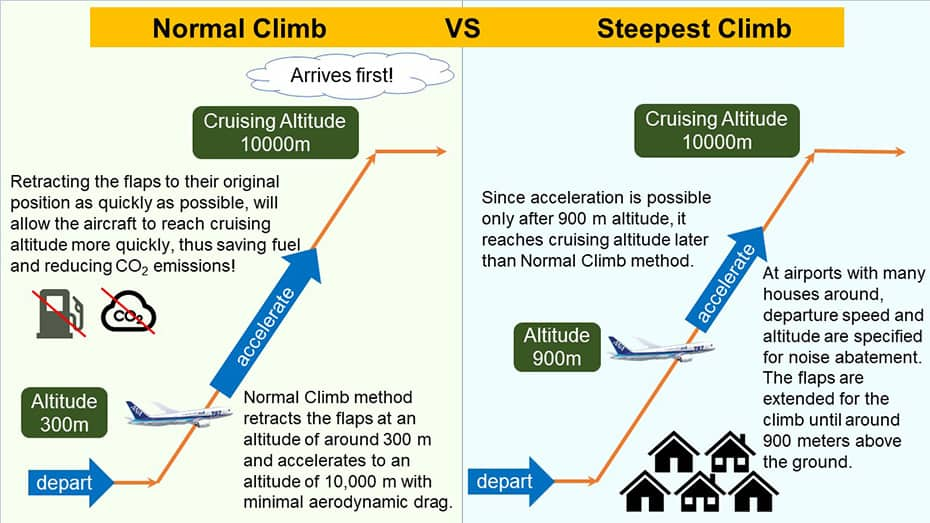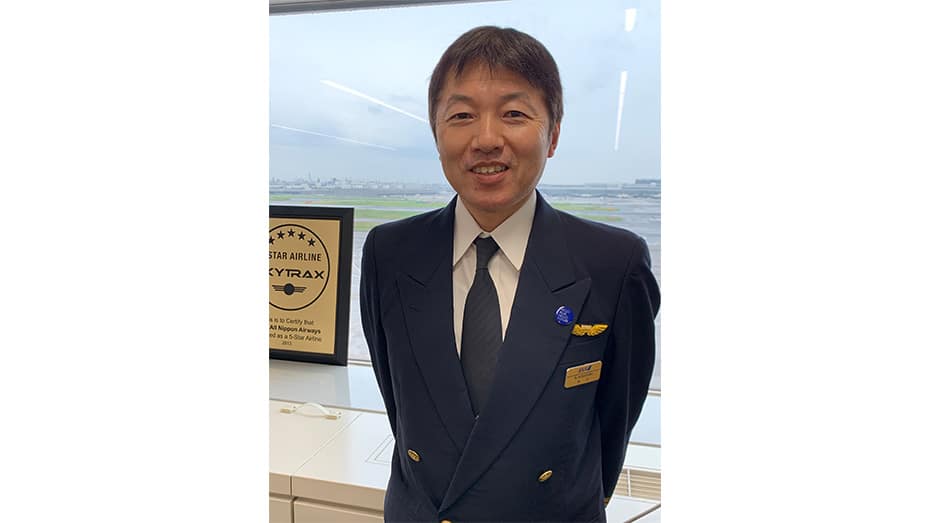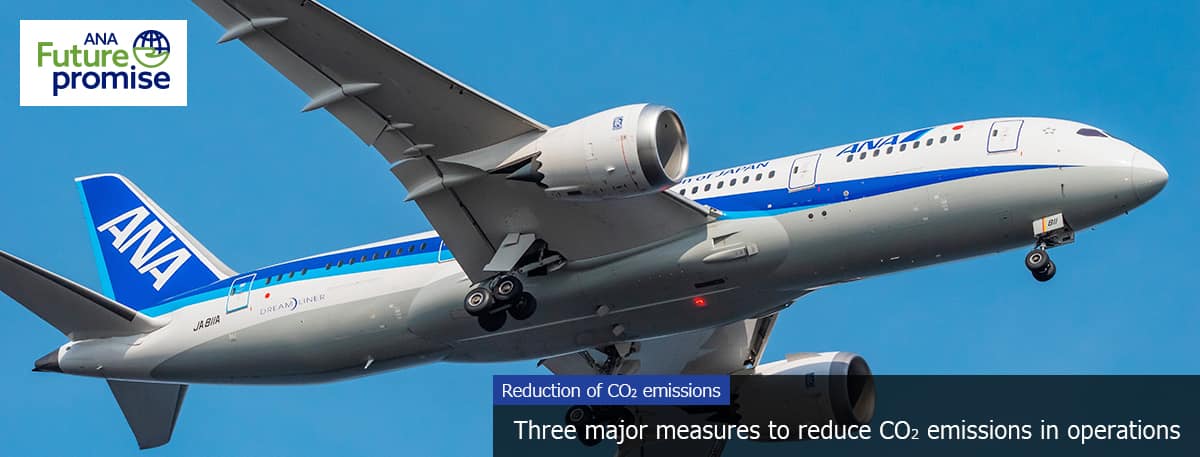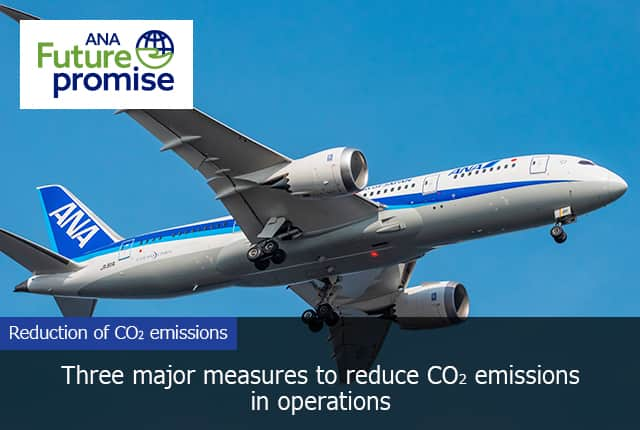October 31, 2022
We will introduce three major measures that ANA has taken over the years to reduce CO₂ emissions from flight operations.
First measure: "Normal Climb"
Airplane wings have flaps that extend and retract to change the size of the wing area. During takeoff, the flaps are extended to widen the wing area, allowing the aircraft to climb at lower speeds with lift. While flying with the wing area extended, air resistance also increases, making it difficult to increase the speed. Also, the longer the flaps are kept extended, the less fuel efficient the aircraft will be. The measure to reduce aerodynamic drag by retracting the flaps early after takeoff (around 300 m altitude) to reach the cruising altitude (around 10,000 m) more efficiently, is called "Normal Climb" and is linked to fuel savings and reduced CO₂ emissions.

Explanation with images of Normal Climb
Conversely, there is also the "Steepest Climb" method, in which the aircraft climbs to a certain altitude (usually around 900 m) with the flaps extended after takeoff. At some airports, the altitude and speed after takeoff are specified to reduce noise, and at such airports, the Steepest Climb method is performed by keeping the flaps extended to an altitude of around 900m. Although this method is effective in reducing noise, it also increases the time of aerodynamic drag compared to the Normal Climb, and as a result, more fuel is consumed in the climb. It is more fuel efficient to retract the flaps and return them to their original position as quickly as possible.

Comparison of Normal Climb and Steepest Climb
At airports where no altitude or speed restrictions are specified, ANA uses the Normal Climb method to contribute to the reduction of CO₂ emissions as much as possible. The implementation of Normal Climb contributes to a reduction of approximately 2,983 tons of CO₂ emissions per year (actual results for 2021) compared to the case where Normal Climb is not implemented. The 2,983 tons is equivalent to the weight of approximately 8.5 aircrafts of ANA B777-300ER airplanes.
Second Measure: "Reverse Idle"
After landing, airplanes are slowed down using thrust reversers and brakes. When reverse thrust is active, it changes the direction of airflow emitted from the engine to help slow the aircraft down quickly.

How the thrust reverser works
However, using thrust reversers consumes a lot of fuel. If the runway for landing is long enough and there is no safety issue, the engine power when using the thrust reversers can be adjusted to a lower level, thereby reducing fuel consumption, leading to CO₂ emissions reduction and also reducing noise. This measure is called "Reverse Idle" because the use of thrust reversers are kept at idle level.
The implementation of the Reverse Idle leads to a reduction of approximately 10,608 tons of CO₂ emissions per year (actual results for 2021) compared to the case where the Reverse Idle is not implemented. Approximately 10,608 tons is equivalent to the weight of about 30.5 aircrafts of ANA B777-300ER airplanes.
Third Measure: "One Engine Taxi In"
Airplanes are equipped with two engines, one on the right side and one on the left side, but one engine is sufficient for ground taxiing after landing. This is called "One Engine Taxi In," where one engine is turned off after landing and only one engine power is used for taxiing on the ground.

Airplane engines
It is not always acceptable to stop one engine after landing. When the ground is slippery due to snowfall or when it is windy, stopping one engine can affect the balance between the left and right sides of the airplane, causing a phenomenon similar to when a car slips. There are also rules for each type of aircraft, such as the mandatory 5-minute engine cooling time after landing for B787 aircraft. Therefore, One Engine Taxi In is only conducted when the pilot checks the weather and the environment around the airplane and determines that there is no problem even with one engine. This is especially practiced for B767 aircraft, which have enough power for Taxi In with one engine.
This One Engine Taxi In measure has reduced CO₂ emissions by approximately 1,909 tons per year (actual results for 2021). Approximately 1,909 tons is equivalent to the weight of about 5.5 aircrafts of ANA B777-300ER airplanes.
Efficient Flight Program
For these three major measures, we collect performance data and provide monthly feedback to flight crews on the implementation rate, CO₂ emission reductions, and other results. In addition, we also provide information that is useful for the implementation of these measures, for example, we have prepared and provided to flight crews a graphic representation of the slope of taxiways at each airport to help them make decisions on the implementation of the One Engine Taxi In. The Efficient Flight Program is an internal initiative that encourages ANA flight crews to take measures to reduce fuel consumption and CO₂ emissions in their operations, and the three major measures introduced here are among them. We are promoting the Efficient Flight Program with safety first in mind, and then considering what we can do to protect the environment.
Interview with the person in charge
We interviewed Captain Nishikawa from ANA Operations Support Center who is also in charge of Efficient Flight Program.

Captain Nishikawa from ANA Operations Support Center
What kind of work do you usually do?
I am usually flying on the B777 aircrafts, mainly on U.S. and European routes. I am also in charge of domestic and cargo flights to China. Apart from regular flights, I work with my department to promote measures such as the Efficient Flight Program, inflight crew announcements, and future crew work styles together with my staff.
Why are "Normal Climb," "Reverse Idle," and "One Engine Taxi In" the three major measures?
This is because they are highly effective in reducing fuel consumption and CO₂ emissions. Other measures are also effective as well, but these three measures are definitely the axis of the company's efforts. In contrast to other fuel reduction measures led by the company, the implementation rate of these three measures largely reflects the awareness, ingenuity, and cumulative efforts of the crew members. Therefore, we hope to raise the awareness of each individual, which in turn will raise the awareness of the entire flight operations department, leading to an increase in the implementation rate and thus to a reduction in CO₂ emissions.
Outlook for the Future
Fuel Dashboard (a tool for visualization of fuel reduction) was introduced last year, and more detailed data can now be extracted. We can now easily see the implementation rate of each airport and compare them to determine the true causes for low implementation rate airports. Of course, it is not only about the three major measures. We are also considering the use of analytical tools to analyze various data and link them to other initiatives.
With the airline industry suffering from the COVID-19, pilots must have felt a sense of crisis. During the reduction of flights due to the COVID-19, the implementation rate of the Efficient Flight Program measures improved significantly. The Efficient Flight Program Committee will continue to disseminate effective information so that the momentum for eco-friendliness that has been fostered will keep increasing in the future.







